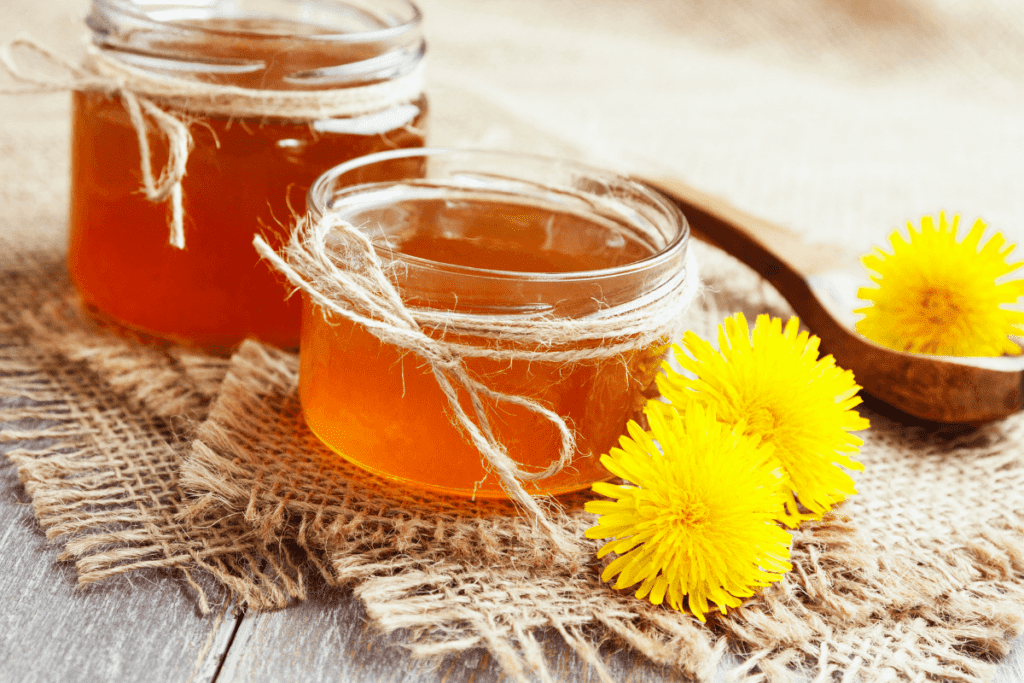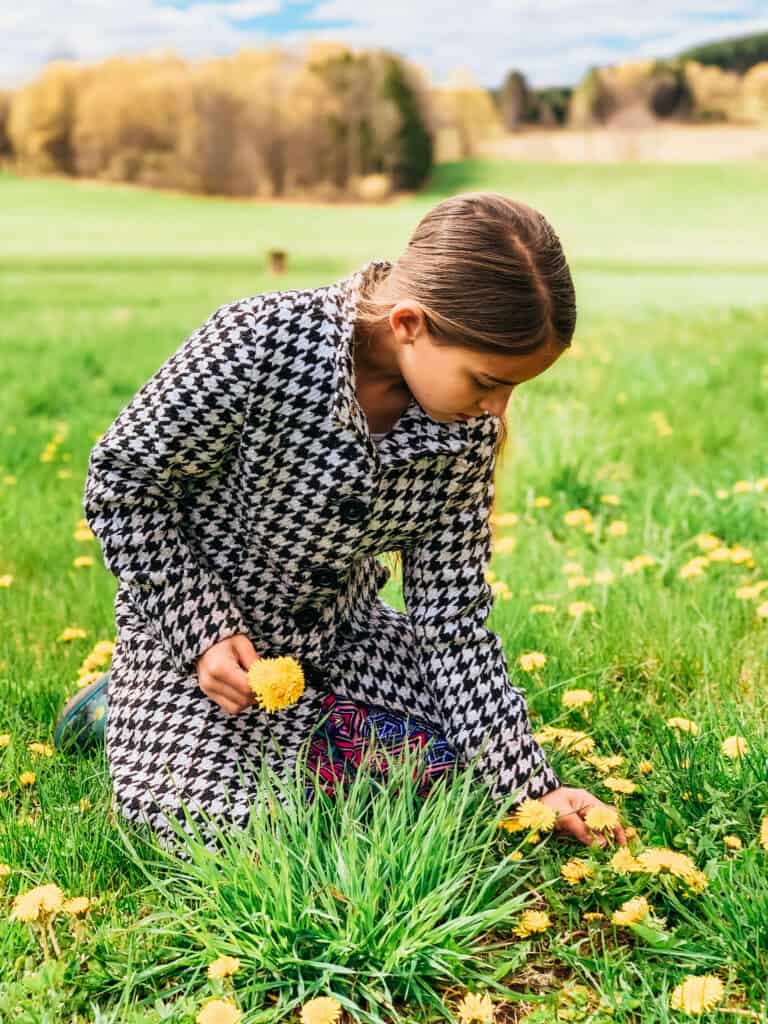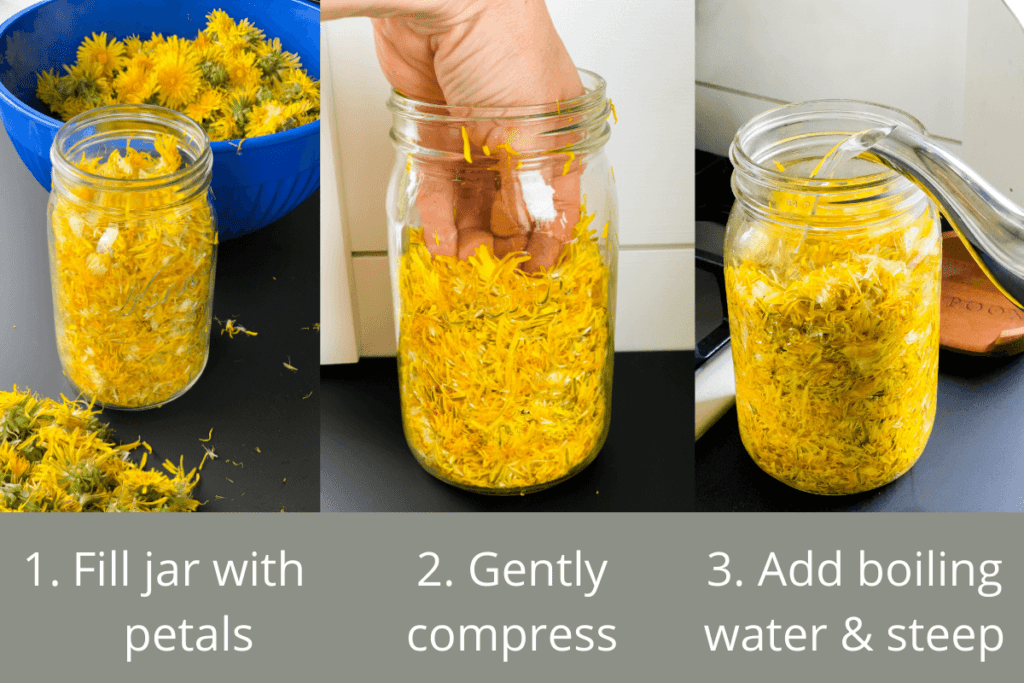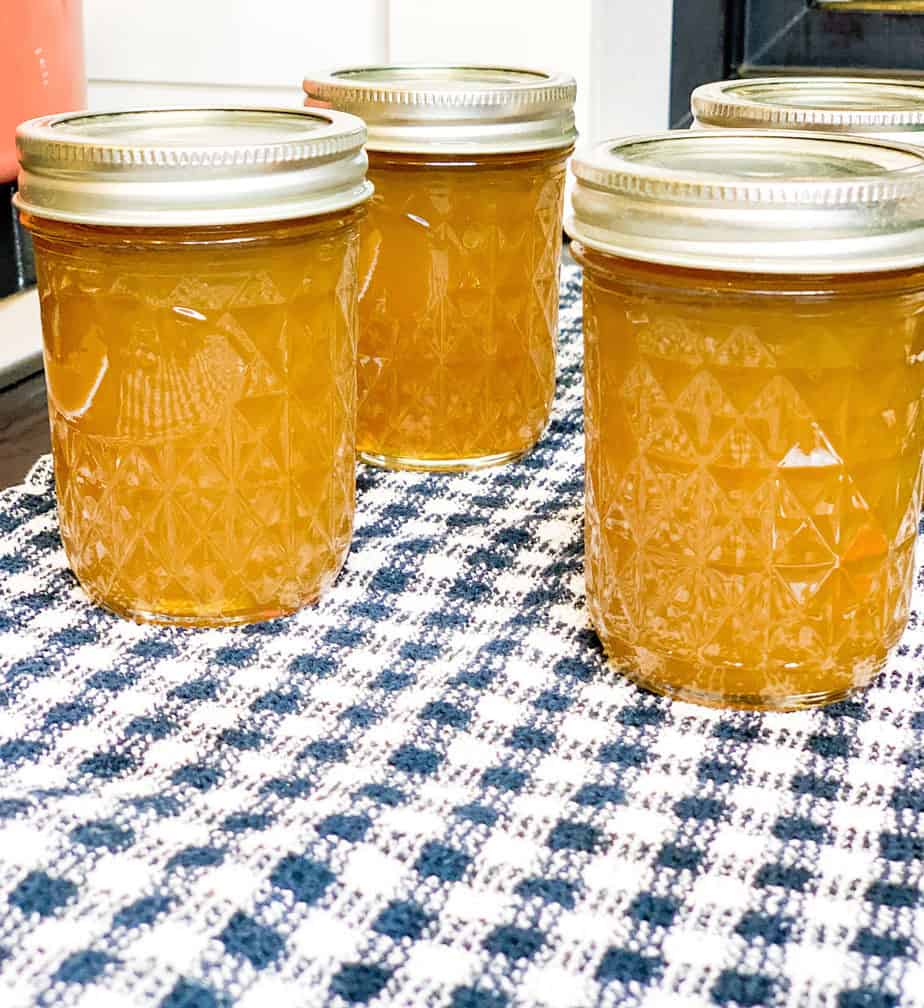This post may contain affiliate links. Please read our affiliate disclosure.
This honey-sweetened dandelion jelly will have you foraging in your front yard. You will never look at these “weeds” the same again!

Growing up, I only thought of dandelions as weeds. My parents used chemicals to get rid of them, and mowed them down so they wouldn’t go to seed. As a young homeowner, I spent hours out in my lawn digging them up and tossing them into the compost pile!
It wasn’t until my early 30s that I heard that dandelions are actually edible. In fact, every part of the plant is edible and useful in many different ways.
After you read about all of their amazing benefits you will definitely want to try this honey-sweetened jelly. And once you try the jelly? You’ll be looking at these “weeds” in a whole new way as well!
What are the health benefits of eating dandelion flowers?
While all parts of the dandelion are edible, the flowers specifically contain polyphenols, which are known to prevent degenerative diseases, cardiovascular disease, and cancer. The flowers also contain antioxidants, which help protect against conditions such as atherosclerosis, diabetes, Alzheimers, and many more conditions!
There have even been studies done on rats that show the flowers may reduce inflammation, which is a problem often at the heart of many different conditions. In addition, ongoing research suggests that they help in treating and preventing cancer, due to the anti-angiogenic properties of their extracts.
If that wasn’t enough to convince you that dandelions may be worth eating, they are also a great source of Vitamin A, and Vitamin B12, and potassium!
Dandelion Root vs. Dandelion Flowers
My first experience actually consuming the plant was in the form of a store-bought tea. It was bitter, and I decided that although deemed edible, it wasn’t for me. In all fairness, I never tried sweetening the tea.
If you have also tried dandelion tea, know that most teas are made using the root, not the petals. The root does tend to have a more bitter taste.
Over this past year, as a part of my mission to live more self-sufficient, I have decided to learn more about foraging. After seeing some posts about making dandelion jelly on social media, and realizing my new field was covered in them, I decided that this would be an excellent place to start.
Despite my previous experience not liking the tea, I wanted to give them a second chance in a different form. I was pleasantly surprised to find that the flower petals were much sweeter!

Sugar-Free Dandelion Jelly
There was only one problem. Every recipe I could find for making dandelion jelly used a massive amount of refined sugar. This seemed to defeat the purpose I was trying to achieve, so I decided to experiment with using only Pomona’s pectin (all-natural powdered pectin made for low-sugar and no sugar recipes) and honey as a sweetener.
After a few attempts, I finally have this recipe perfected and I cannot wait to share it with you!
One important thing to remember before we get started is to always make sure the plants that you forage are not sprayed with harmful chemicals or in a location where they might be unclean (i.e. the chicken pen!). You can give them a rinse if you’d like, but I usually just pick from areas I trust and skip that step.
Ok, let’s do this!
How do you make dandelion jelly without refined sugar?

- Gather your ingredients. You will need:
- A large bowl full of dandelion heads (approximately 16 cups before sorting)
- Pomona’s Pectin
- Honey
- Muslin or a flour sack towel
- A 4 cup glass container or quart-size canning jar
- If you plan to can the jelly you will also need:
- 4 8 oz. jelly jars with lids and bands
- A large pot or water bath canner
- Start by picking dandelion heads. You want ones that are fully flowered out and mature. If the centers are still closed, they are not yet mature and will taste more bitter. This is a great task for kids to help with!
- Next, you are going to remove the yellow petals from the flower and add them to your 4 cup container or quart jar. You can either pick the petals off by hand, or cut them off with scissors, but try to avoid getting any of the green leafy parts into the jar. This step is the most tedious and time consuming, but can also be done easily by kids and goes quickly with many hands doing the work. You will continue doing this until the petals are filled all the way to the top. Then lightly press down. The slightly compressed flower petals should equal approximately 3 cups.
- Now, heat up 4 cups of water until boiling, and add it to your jar until completely full of the boiling water and flower petals. Let this “tea” steep for a minimum of 4-5 hours. I’ve let it sit overnight as well.
- Next you are going to strain the liquid away from the mixture. I found that lining a colander with a flour sack towel was the best way to do this. You can then give the towel a squeeze to get any remaining liquid out of the flower petals.
- Now is a good time to heat up your jars and prep your canning supplies if you will be canning the jelly. I like to fill my canner to the height of my jars with water and bring it to a boil while I’m prepping my recipe. If you need to sterilize your jars, let it boil for 10 minutes. If you are just heating them, shut off the heat and let them sit in the hot water until you are ready to use them.
- You will then pour the strained liquid into a pot over medium heat. If you want to be precise, the liquid should measure 3 ¼ cup.
- Add ¼ cup of lemon juice and 4 tsp. of calcium water to the mixture, and stir well. If you have never used Pomona’s Pectin before, follow the instructions that come with it for making and storing the calcium water. It’s very simple to mix up and can be stored and used for future recipes.
- Whisk well, and slowly bring the mixture to a boil.
- While the mixture is heating up, measure out 1 ½ cups of honey into a separate bowl.
- Add 4 tsp.of the pectin powder to the honey, and whisk well until fully dissolved in the honey.
- After your tea mixture comes to a boil, slowly start adding the honey and pectin, whisking briskly to combine.
- Remove your jars from the canner and set on a dry towel near the stove. A jar lifter and funnel are helpful tools if you have them.
- Bring the mixture back to a boil, continuing to whisk well so that the honey and pectin are evenly distributed. It will foam up a bit. Just continue to stir until it boils at a rolling boil for 1 full minute. Make sure you are getting along the bottom edge of your pot with your whisk, as the pectin likes to settle there.
- Then, after boiling for 1 minute, shut off the heat and immediately distribute the mixture into your canning jars.
- Wipe the edges of the jars with a wet paper towel and place your canning lids and bands on. Tighten the bands with one hand, secure, but not too tight!
- Let cool on the towel without disturbing them until they are completely cool and the lids have sealed.
At this point, you can remove the bands and store! Enjoy!


Dandelion Jelly Recipe (Honey-Sweetened)
Ingredients
- A large bowl full of dandelion heads approximately 16 cups before sorting
- Pomona’s Pectin
- Honey
- Muslin or a flour sack towel
- A 4 cup glass container or quart-size canning jar
- 4 8 oz. jelly jars with lids and bands
- A large pot or water bath canner
Instructions
- Start by picking dandelion heads. You want ones that are fully flowered out and mature. If the centers are still closed, they are not yet mature and will taste more bitter.
- Remove the yellow petals from the flower and add them to your 4 cup container or quart jar. You can either pick the petals off by hand, or cut them off with scissors, but try to avoid getting any of the green leafy parts into the jar. You will continue doing this until the petals are filled all the way to the top. Then lightly press down. The slightly compressed flower petals should equal approximately 3 cups.
- Heat up 4 cups of water until boiling, and add it to your jar until completely full of the boiling water and flower petals. Let this “tea” steep for a minimum of 4-5 hours. I’ve let it sit overnight as well.
- Strain the liquid away from the mixture. I found that lining a colander with a flour sack towel was the best way to do this. You can then give the towel a squeeze to get any remaining liquid out of the flower petals.
- Heat up your jars and prep your canning supplies if you will be canning the jelly. I like to fill my canner to the height of my jars with water and bring it to a boil while I’m prepping my recipe. If you need to sterilize your jars, let them boil for 10 minutes. If you are just heating them, shut off the heat and let them sit in the hot water until you are ready to use them.
- You will then pour the strained liquid into a pot over medium heat. If you want to be precise, the liquid should measure 3 ¼ cup.
- Add ¼ cup of lemon juice and 4 tsp. of calcium water to the mixture, and stir well. If you have never used Pomona’s Pectin before, follow the instructions that come with it for making and storing the calcium water.
- Whisk well, and slowly bring the mixture to a boil.
- While the mixture is heating up, measure out 1 ½ cups of honey into a separate bowl.
- Add 4 tsp.of the pectin powder to the honey, and whisk well until fully dissolved in the honey.
- After your tea mixture comes to a boil, slowly start adding the honey and pectin, whisking briskly to combine.
- Bring the mixture back to a boil, continuing to whisk well so that the honey and pectin are evenly distributed. It will foam up a bit. Just continue to stir until it boils at a rolling boil for 1 full minute. Make sure you are getting along the bottom edge of your pot with your whisk, as the pectin likes to settle there.
- Then, after boiling for 1 minute, shut off the heat and immediately distribute the mixture into your canning jars leaving 1/4 inch headspace.
- Wipe the edges of the jars with a wet paper towel and place your canning lids and bands on. Tighten the bands with one hand, secure, but not too tight!
- Place the jars in your canner, making sure they are covered with 2-3 inches of water. Cover and bring to a boil.
- Process for 5 minutes in your water bath canner. Turn off the heat and let cool 10 minutes before removing jars.
- Let cool on the towel without disturbing them for 12 – 24 hours. Ensure that the lids have sealed before storing.
Video
How long is dandelion jelly good for?
Canned, the jelly is best used within a year. Once opened, the jelly is good in the refrigerator for up to two weeks.
Do I have to use Pomona’s Pectin?
No, you can use a different type of pectin, but you must follow the instructions given with that pectin, which usually includes adding sugar. You cannot use 100% honey for the sweetener with most types of pectin.
What does dandelion jelly taste like?
Dandelion jelly tastes a lot like honey (even before sweetening it with honey!) with a slight brassica undertone. I think you will be pleasantly surprised!
Here are some more interesting facts about dandelions!
What is the scientific name for dandelions?
The botanical name for dandelion is taraxacum officinale.
Are dandelions native to the United States?
No! Dandelions were originally brought to America from Europe and Asia for their health benefits.
What are some other names for dandelions?
Blow Ball Cankerwort, Lion’s Tooth, Puff Ball, Pissabed Priest’s Crown, Pu Gong Ying, Swine Snout, Telltime, White Endive.
In French they are called pissenlit, which literally means ‘bedpissers’ due to their diuretic properties
What is the origin of the word dandelion?
The English name, dandelion, comes from the jagged shape of its leaves, which the Medieval French deemed “Dent-de-lion.” This literally means “lion’s tooth.”
Are all part of a dandelion edible?
Yes! Each part of the dandelion has different uses and medicinal properties.
Can eating dandelions make you sick?
Yes, but understanding why it might will alleviate any fears you may have about consuming them. Some people are allergic to the pollen on dandelions. If you have seasonal allergies, you may want to save the harvesting for someone else, and proceed slowly with consuming them.
Recent studies on allergies make me believe that exposure to pollen in small amounts may actually be beneficial! Of course, if you notice any sign of allergy, contact your doctor, or in the case of an anaphylactic reaction, call 911!
There have also been rare cases of poisoning caused by consuming excessive amounts of dandelion tea, or by children who have consumed a large number of stems. As long as you remember that anything with medicinal properties can be dangerous in large quantities, you will be just fine!
One other possible danger of consuming dandelions is actually caused by the toxins that are often sprayed on them. This can be avoided by only consuming dandelions you have grown yourself and know to be unsprayed.

Lovely recipe that I plan to try out once we have enough dandelions in our yard 🙂
Yes, can’t wait for spring! I hope that you love it!
I see in one of the steps to use calcium water, but I don’t see this in the ingredients. What is calcium water? Thank you!
Hi there! Calcium water is included with Pomona’s Pectin. This type of pectin is basically a two-step process. There are instructions in the box to explain how to mix it and use it.
Thankis for sharing your thoughts. I truly appreciae yur efforts
and I am waitging forr your ffurther wtite ups tanks once
again.
I have tried this twice and it is more like syrup. Followed exactly.
It’s most likely your pectin. Are you using Pomona’s?
Question: you state IF YOU PLAN TO CAN your jelly. Does that imply canning is NOT necessary if I plan to give away immediately and not store?
Correct. You do not have to can it, but then it needs to be kept refrigerated or frozen.
Can I let the dandelion’s steep 2 or 3 day before processing into the jelly?
You could, but I would refrigerate them when doing this.